The Allure of Artificial Fig Trees in Home Design


Intro
In the realm of interior decor, the charm of fake fig trees has taken roots in the hearts of homeowners and designers alike. These artificial wonders mimic the lush greenery of real fig trees without the fuss of maintenance and care. In this article, we’ll explore the multifaceted appeal of these decorative fixtures, dissecting their practicality, aesthetic contributions, and how they seamlessly integrate with various interior design trends.
Furniture Trends and Styles
The integration of aesthetic components within living spaces often necessitates a nuanced understanding of current trends. The heightened interest in biophilic design—where nature is seamlessly woven into indoor environments—has fostered a rapid rise in the demand for artificial plants, with fig trees at the forefront. They're admired for their rich green hues and structure, providing a touch of elegance without the responsibility of tending to live vegetation.
Current Trends in Furniture Design
Furniture that reflects a mix of functionality and contemporary style tends to dominate both showrooms and homes. Trends oscillate toward sustainable materials and designs that evoke a sense of calm. Here, faux greenery, particularly fake fig trees, complements trends like minimalism and Scandinavian aesthetics. The beauty lies in their ability to lend an air of sophistication while being low-key, alleviating the need for constant upkeep.
Popular Furniture Styles and Their Characteristics
The rise of certain furniture styles can enhance the appeal of a fake fig tree. For instance:
- Mid-Century Modern: This style emphasizes clean lines and organic forms, allowing fake fig trees to fit as elegant accessories that soften sharper lines in furniture pieces.
- Industrial: Typically highlighted by raw materials like metal and wood, adding a fake fig tree brings a hint of life into a more rugged setting.
- Rustic: Known for its warm and by-gone charm, a faux fig tree can complement the rugged textures, providing a refreshing contrast.
Fake fig trees can play well into these stylistic elements, enhancing the overall design and atmosphere of the space. With various leaves and hues available, these artificial plants can mirror the individual tastes of homeowners and designers, making them a versatile, attractive, and timeless option for indoor decoration.
"In an era where our lives are increasingly busy, the option to infuse greenery without effort is a breath of fresh air."
Buying and Maintenance Guides
When it comes to sprucing up your space with a fake fig tree, understanding what to seek in quality and style is key. Buying the right faux tree ensures that it not only looks realistic but also resonates with your personal aesthetic.
Essential Tips for Purchasing Furniture
- Material Quality: Opt for trees made with high-quality materials that replicate natural foliage. Look for UV-resistant options if you'll be placing them near sunlight.
- Size Consideration: Ensure the tree matches the scale of your room and furniture—which can make a big difference in visual balance.
- Color Variation: Don’t settle for a one-toned tree; seek out designs that mimic the sporadic color patterns of real foliage for a more authentic look.
Maintenance and Care for Different Furniture Materials
While fake fig trees are relatively easy to maintain, a little care goes a long way in preserving their charm.
- Dust Regularly: Faux leaves can gather dust, particularly those that have intricate detail. A gentle wipe with a damp cloth will do wonders.
- Avoid Direct Sunlight: Though many are UV resistant, placing them in direct sunlight for extended periods may fade their color over time.
Understanding Fake Fig Trees
Definition and Overview
Fake fig trees, often crafted from materials like plastic or synthetic fabrics, have made their way into countless homes and offices. These decorative items not only mimic the lush foliage of real fig trees but also bring numerous benefits that live plants simply can't match. For those who appreciate the aesthetic appeal of greenery but may lack the green thumb or time to care for them, these artificial counterparts present an attractive solution.
From simplistic designs to intricate representations, fake fig trees can complement various interior styles. With vibrant, diverse leaf colors and shapes, they can enliven a dull corner, creating a sense of warmth and vibrancy. Unlike real plants, they don’t wilt or lose leaves, making them a reliable choice for enhancing decor without the constant upkeep. Moreover, they convey elegance and sophistication without breaking the bank.
Recognizing the broad appeal of fake fig trees is key in today’s design landscape. Homeowners, decorators, and retailers can transform spaces effortlessly, making these ornamental plants not only a choice but rather a statement of style and convenience. In a world where upkeep often falls to the wayside, the timeless allure of artificial greenery can't be overstated.
Comparative Analysis with Real Fig Trees
When pondering over indoor greenery, one must weigh the difference between real fig trees and their artificial counterparts. While real plants bring life and can purify the air, they demand a good bit of attention. Watering, fertilizing, and providing adequate light are essential practices that ensure that a live fig tree thrives.
In contrast, fake fig trees stand out due to their low maintenance requirements. They require no sunlight, no watering, and no worrying about pests. This aspect not only simplifies ownership but also opens doors for creative placement in spaces where real plants might struggle.
"While real plants may enhance air quality, the consistent aesthetics and ease of maintenance of fake fig trees offer a unique balance of beauty and convenience."
Furthermore, the lifespan of a fake fig tree can far exceed that of a live alternative. No matter the conditions, be it a sunless nook or a drafty hallway, fabricated trees remain steadfast year after year. With options available that can replicate the intricate details of actual foliage faithfully, the line between the two becomes increasingly blurred.
In a nutshell, while real fig trees come with their unique charm, fake fig trees cater well to the modern lifestyle, appealing especially to those who appreciate beauty and convenience in their indoor spaces.
Material Composition
Understanding the material composition of artificial fig trees is essential for several reasons. The right materials not only affect the overall appearance but also the durability, maintenance, and environmental impact of these decorative pieces. For homeowners and decorators looking to add a touch of greenery without the fuss of living plants, the composition of fake fig trees plays a crucial role in deciding which type of tree to choose.
Types of Materials Used
Plastic
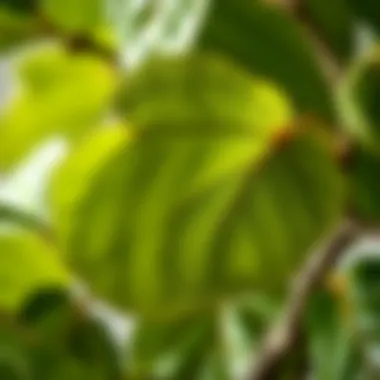

Plastic is one of the most common materials in the production of fake fig trees. Its popularity largely stems from its flexibility and resilience. This material can be molded into various shapes, allowing for a variety of styles and sizes that can fit into any space. A significant characteristic of plastic is its weather resistance, meaning it can be used indoors without concern for fading or deterioration. However, one downside could be the impression of artificiality, which some may find off-putting. When done right, high-quality plastic trees can closely mimic the look of natural foliage while standing the test of time.
Synthetic Fabrics
Synthetic fabrics bring a different texture and feel to artificial fig trees. These materials can be made to resemble real leaves more closely than plastic, bringing an element of softness that can enhance the visual appeal. A key characteristic of synthetic fabrics is their ability to retain color, making these trees vibrant and visually appealing. They can also be lighter than their plastic counterparts, making them easier to move around. However, they may require additional care, as certain synthetic materials are prone to dust accumulation, which will necessitate regular cleaning.
Paper-Mâché
Paper-mâché offers a less conventional choice for those seeking to incorporate a unique touch into their decor. This material is often hand-crafted, giving each piece an individuality that mass-produced items lack. A distinctive feature of paper-mâché is its biodegradability, making it a more environmentally friendly option. Additionally, it can be painted or enhanced with different finishes to suit various design themes. However, its durability is not as strong as plastic or synthetic fabrics; this can limit its long-term use in high-traffic areas or challenging environments.
Durability and Long-Term Use
When it comes to durability, the material used in fake fig trees plays an even more vital role. Plastic trees are generally long-lasting and can endure the test of time without significant aesthetic decline. Synthetic fabric trees require mindful handling but can still offer a solid investment if cared for properly. In contrast, paper-mâché trees, though charming and unique, may not withstand years of wear and tear as effectively as their plastic or fabric counterparts. It's essential for buyers to align their choices with the intended use and location of their artificial plants. This can ensure that the selected option serves its purpose effectively while also enhancing the indoor space as desired.
Aesthetic Considerations
When it comes to decor, aesthetics play a fundamental role in creating spaces that resonate with personal style and comfort. Fake fig trees, in particular, bring a sense of greenery that can be both inviting and stylish, allowing homeowners and decorators to achieve their desired ambiance. These artificial plants not only mimic the beauty of their living counterparts but also offer myriad options concerning style and arrangement without the accompanying hassles of maintenance. In this section, we will delve into various aspects of aesthetic considerations, focusing on how realistic appearance and integration into design themes contribute significantly to the appeal of fake fig trees.
Realistic Appearance
Color Variations
The beauty of color variations in fake fig trees cannot be overstated. The diversity of hues available—from dark green to lighter, variegated shades—adds depth and dimension, simulating the natural gradients found in real plants. A standout feature is the ability to choose specific colors that align with your room’s color palette, creating a seamless blend with existing decor.
Positive aspects of color variations include:
- The flexibility to match or contrast with interior colors
- Ability to create focal points within a space
- Reduced likelihood of color fading over time compared to real plants
However, one must also consider that overly bright color choices can risk looking artificial, thus choosing more subdued tones often proves to be a beneficial approach. Striking a balance between vibrancy and realism is crucial for achieving that organic vibe.
Leaf Textures
Another important aspect of aesthetic appeal in fake fig trees is leaf texture. Many manufacturers go to great lengths to replicate the intricate designs found on real fig leaves—from smooth, polished surfaces to rough edges mimicking a natural look. This textural difference is significant, as it not only affects the appearance but also how the plant feels in a living space.
Key characteristics include:
- Varied textures (some leaves glossy, others matte)
- Enhanced dimensionality that comes from differing leaf shapes
- The ability to create a lifelike interplay of light and shadow
Nevertheless, not all textures convey realism. A cheap, overly shiny finish may detract from the authenticity that homeowners often seek. The choice of textures should harmonize with the overall ambiance intended in the room.
Integration into Design Themes
Modern Minimalism
In the realm of modern minimalism, fake fig trees stand out as a versatile element that does not overwhelm the space. The clean lines and understated grace of these trees make them an ideal choice, closely aligning with the minimalist philosophy that celebrates simplicity and functional beauty.
Characteristics making them appealing in such spaces include:
- Low maintenance aligns with a clutter-free aesthetic
- Easy adaptability to various furniture styles
- Potential as living art pieces that elevate the room's feel
The main challenge lies in ensuring that the tree does not become too large or ostentatious; subtler pieces tend to complement minimalism better without drawing undue attention.
Bohemian Style
Fantastically chaotic, the bohemian style thrives on layers, colors, and eclectic arrangements. Fake fig trees fit snugly into this design ethic, adding an element of organic texture while allowing for vibrant personal expression. These trees can act as grounding elements amidst a sea of patterns and textiles.
Benefits of incorporating fake fig trees include:
- Freedom to experiment with oversized pieces without worrying about upkeep
- The ability to complement or clash intentionally with other decorative items
- Infusion of life into spaces sometimes too busy otherwise
However, the key is to avoid over-cluttering. A single, well-placed fake fig tree can often create a more meaningful statement than multiple smaller pieces.
Scandinavian Influence
The Scandinavian approach to design focuses on functionality and simplicity with an appreciation for nature. Fake fig trees harmonize beautifully with this ethos, as they bring in the essence of the outdoors while maintaining the tidy, crisp aesthetic synonymous with Scandinavian interiors.
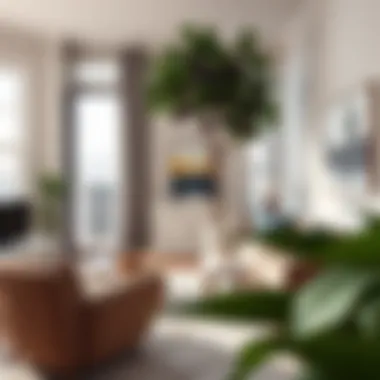
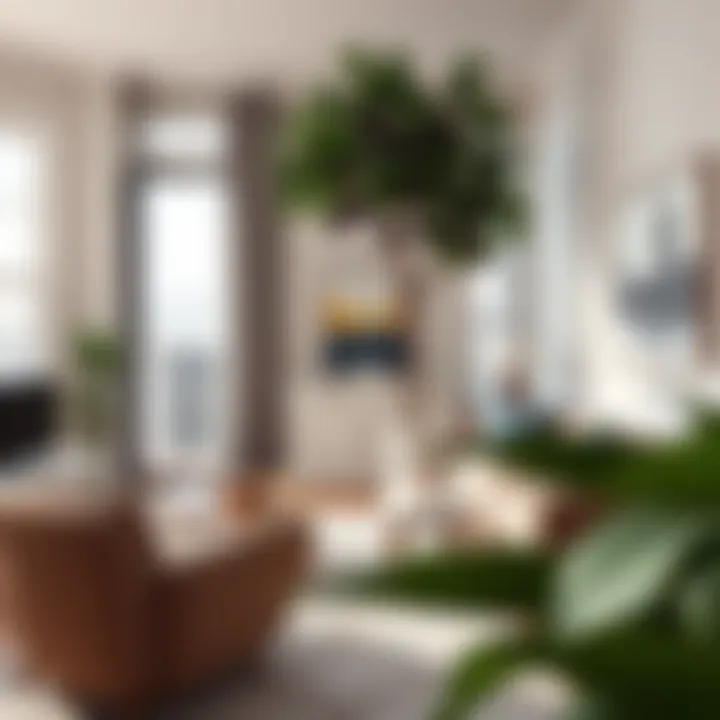
Why they are favored in this style:
- Faux greenery introduces warmth and liveliness without compromising minimalism
- Their norms of natural materials align well with a clean and airy feel
- Subtle diversities in colors and textures enhance the understated elegance without overwhelming other elements
The only downside could be if the faux greenery appears too polished; it risks feeling out of place in a relaxed environment that values authenticity. Successful integration involves choosing pieces that echo natural forms and textures.
Ultimately, the aesthetic consideration when selecting fake fig trees should be rooted in not just personal style, but also how effectively these pieces enhance the existing atmosphere of a space. This strategic incorporation of artificial greenery fosters unique designs without losing the essence of a curated home.
Placement Strategies
When it comes to enhancing the aesthetics of indoor spaces, the strategic placement of fake fig trees plays a crucial role. Selecting the right location can amplify the visual appeal of a room, create a sense of balance, and contribute positively to the overall atmosphere. It’s not just about putting a plant in a corner; it's about maximizing the beauty and impact while ensuring the plant fits seamlessly into the existing decor.
Ideal Locations Within the Home
Living Rooms
The living room is often considered the heart of the home, where families gather and visitors feel welcomed. Therefore, placing a fake fig tree in this space can significantly boost its visual charm. The vibrant greens and large leaves can serve as a stunning focal point without the hassle of maintenance. They can complement any furniture style, whether it’s modern minimalism or classic elegance.
Additionally, the unique feature of a fig tree's height can add verticality to the living room layout, drawing the eye upwards and making the space feel larger. However, it is essential to position it so that it does not block pathways or sitting areas, keeping the space free-flowing and accessible.
Entryways
Entryways are often overlooked when it comes to decor, yet they set the tone for the rest of the home. A fake fig tree placed strategically in an entryway can create an inviting ambiance as soon as guests step through the door. The lush foliage adds warmth and interest to an otherwise utilitarian space.
One of the entryway's unique features is its transitional nature, linking the outside world with the interior. Using an artificial fig tree here highlights the transition from the outdoors to the internal warmth of home. Still, size matters; too large of a tree can make the space feel cramped, so select a height that harmonizes well with door frames and ceilings.
Offices
The office is another prime location for faux foliage. Studies show that greenery can boost productivity and enhance mood, making a fake fig tree an excellent choice for those long hours spent working. Its presence not only beautifies the workspace but also contributes to a healthier atmosphere, fostering creativity and focus.
The unique aspect of office setups is their often limited real estate; thus, a tall, slender fig tree can fit snugly in corners or next to desks without overwhelming the space. However, it's important to pair the tree with the right furniture to avoid style clashing; the intention should be a cohesive look that promotes professionalism without sacrificing comfort.
Height and Scale Considerations
When adding a fake fig tree to your home, consideration of height and scale is paramount. It’s essential for homeowners and decorators to align the size of the plant with the surroundings. A tree that’s too small can be overshadowed by larger furnishings, while one that’s too large can dominate and feel out of place. Here are some useful points to think about:
- Understanding Proportions: Measure the height and width of the area where you want to place the tree.
- Creating Balance: Consider pairing tall trees with lower furniture pieces to create an interesting visual hierarchy.
- Room Functionality: Ensure that the scale of the tree does not obstruct walking paths or interfere with natural light flow.
By paying attention to placement and scale, homeowners can ensure that their artificial fig trees serve not just as decor but as integral elements of their home’s design.
Maintenance Ease
Maintenance ease plays a significant role in the appeal of fake fig trees for indoor living spaces. Homeowners today are juggling busy schedules, often leaving little time for nurturing a variety of delicate houseplants. The artificial fig tree stands out as a practical choice that meets the visual and emotional needs of aesthetics without the labor-intensive upkeep associated with natural plants. Having a lush green fig tree that requires no daily watering or monthly repotting checks all the boxes for those seeking beauty coupled with convenience.
Cleaning and Care Requirements
Though they don’t require the same level of care as a real plant, fake fig trees still benefit from a bit of occasional cleaning. Dust and grime can accumulate on their leaves, diminishing their appearance. A simple regimen includes wiping down the leaves with a damp cloth or using a feather duster to keep them spick and span. Light cleaning, perhaps once a month, doesn’t take much time at all.
It’s wise to avoid harsh chemicals; instead, use mild soap or a gentle all-purpose cleaner if needed. It’s also a great idea to keep them away from places where they might get easily dirty, like kitchen countertops. Put simply, low maintenance doesn’t mean no maintenance.
Longevity Without Special Treatment
One of the most attractive aspects of fake fig trees is their ability to last without the need for special treatment. Unlike their real counterparts that might wilt, droughts, or fall prey to pests, these faux plants can withstand the test of time with a little common sense. Materials used in these trees are often UV resistant, allowing them to retain their colors and textures even when exposed to sunlight for extended periods.
Moreover, they don’t need fertilizers, pruning, or any other labor-intensive care that can often feel like a chore. This inherent durability makes fake fig trees an astute investment. For homeowners wanting greenery in their living spaces without the hassle, they present a compelling argument.
Cost Effectiveness
When it comes to making choices for interior design, cost is often a significant factor. Fake fig trees stand out not only for their aesthetic appeal but also for their cost-effectiveness. Understanding the balance between initial investments and long-term savings can reshape how homeowners perceive and utilize indoor greenery. By weighing the upfront costs against ongoing expenses, one can see the distinct advantages these artificial plants bring to the table.
Initial Investment vs. Long-Term Savings
The initial outlay for a fake fig tree can vary widely, depending on size, quality, and design features. A modest, average-sized fake fig tree might start from around $50, while more elaborate designs can climb to several hundred dollars. The key, however, lies in understanding that this is a one-time purchase that could last for years, or even decades.
Consider the expenses involved with a real fig tree: soil, fertilizers, water, and constant nursing to ensure it thrives. Not to mention, the price tags can balloon if a plant succumbs to pests or requires specialized care. In contrast, a plastic or silk fig tree requires little more than a dusting from time to time.
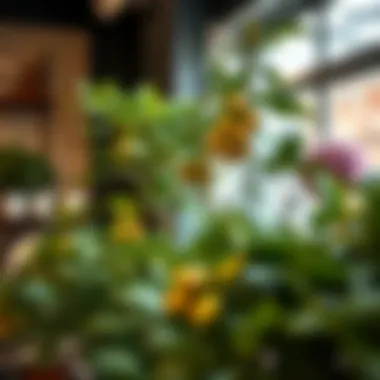
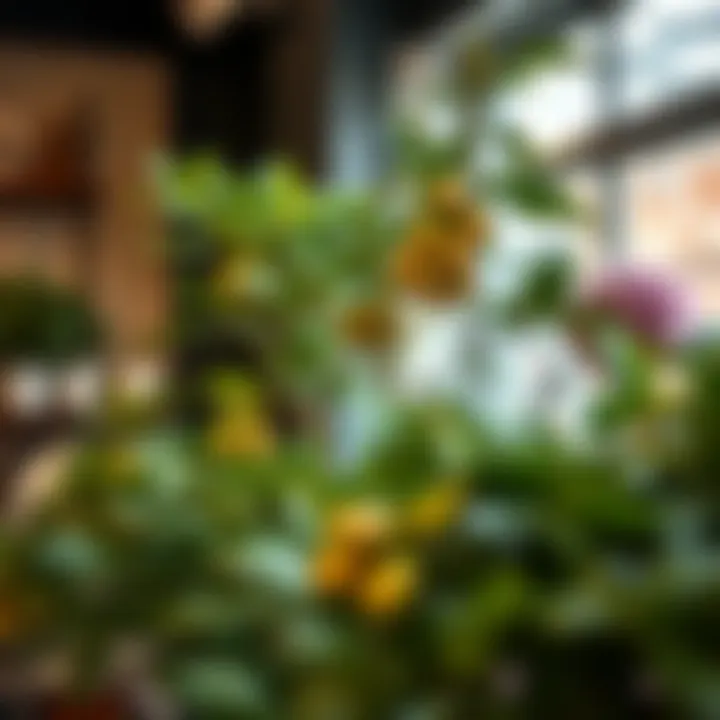
"Investing in a fake fig tree is akin to buying peace of mind. It’s less about what you put out and more about what you save in the long run."
Long-term savings thus come in the form of reduced upkeep and no need for replacing dead plants yearly. The convenience of having greenery without the hassle presents a practical allure that cannot be ignored.
Affordable Options for Various Budgets
Accessibility is another boon of fake fig trees. The market features a wide array of products, ensuring that there’s something for every budget.
- Budget-friendly options start at smaller sizes or less intricate designs, perfect for those just venturing into the world of indoor plants.
- For those willing to spend a bit more, many retailers offer mid-range choices that boast more realistic appearances and better materials.
- Finally, high-end designs appeal to individuals looking to create an impactful design statement in their homes; these varieties often mimic real plants so closely, it’s sometimes hard to tell.
From big box retailers to small boutique shops, the range of options brings choice directly to consumers’ fingertips. Adding a fake fig tree into your interior design doesn’t have to mean breaking the bank or sacrificing quality. With thorough research and consideration, one can find a faux plant that checks all the right boxes without stretching finances too thin.
In summary, fake fig trees represent a strategic investment in home decor; their reasonable initial costs paired with low long-term expenses create a compelling case for any homeowner or decorator looking to liven up their space with minimal hassle.
Evolving Trends
As our living environments continuously evolve, so too does the aesthetic approach to interior design. Among the various elements capturing attention in contemporary home decor, fake fig trees have gained significant traction. This isn't just about adding greenery to your space—it's also about sustainability, convenience, and style. Understanding the evolving trends surrounding fake fig trees opens the door to a plethora of design possibilities while addressing the practicality that modern homeowners seek.
Emergence of Eco-friendly Materials
One of the most notable trends is the shift toward eco-friendly materials in the production of artificial plants. Today’s consumers are increasingly eco-conscious, seeking options that not only beautify their spaces but also align with their values. The emergence of sustainable materials in fake fig trees reflects this demand. Manufacturers are now opting for recyclables, reducing dependency on harmful plastics. This shift not only minimizes environmental impact but also elevates the perceived value of these products.
Specifically, one can find artificial fig trees crafted from materials like recycled plastics or biodegradable options that hint at nature while maintaining a responsible stance on environmental health. A perfect example of this trend is the use of a material like TPR (Thermoplastic Rubber), which is known for its durability and lesser environmental footprint when compared to its traditional counterparts.
Incorporating eco-friendly materials means being able to showcase lush greenery without the guilt often associated with contributing to plastic waste. When you place one of these trees in your living room, you can feel good knowing that it represents a small step towards more sustainable home decor choices.
Influence of Social Media on Design Choices
Another significant influence in the world of fake fig trees stems from the ever-dominant force of social media. Platforms like Instagram and Pinterest have democratized design inspiration, allowing homeowners and decorators alike to showcase their interiors to a global audience. The aesthetic appeal of fake fig trees has not gone unnoticed in this digital arena.
Instagram influencers, home decor bloggers, and even design shows frequently feature these faux plants, propelling them into the spotlight. Homeowners are no longer just accentuating their living spaces; they are aiming for that perfect shot to share online—making the need for low-maintenance, visually appealing decor paramount. The fig tree, with its iconic foliage and striking shape, has proven to be a favorite choice.
When engaging with these platforms, one can often observe recurring design patterns surrounding fake fig trees that emphasize minimalist styles or cozy nooks filled with greenery. This visual culture encourages potential buyers to emulate these curated spaces, thus investing in artificial fig trees more than ever before.
The rise of social media has transformed interior design into an accessible pursuit, allowing trends to spread like wildfire.
Psychological Impact of Indoor Plants
The incorporation of greenery into indoor environments has gained widespread attention due to its notable effects on mental well-being. Understanding the psychological impact of indoor plants, especially artificial ones like fake fig trees, presents a compelling case in this discussion. These plants aren't just decorative pieces; they hold an essential role in enhancing the atmosphere of a space and, by extension, the mood of its occupants. When considering indoor design, the aspect of well-being should not be overlooked.
Benefits of Greenery in Living Spaces
Integrating plants into home decor can yield multiple psychological benefits. These include:
- Reduced Stress Levels: Numerous studies support the idea that being around greenery can lower stress. Even a single fake fig tree, with its lush leaves and vibrant colors, can evoke a sense of calm, bringing a slice of nature indoors without the upkeep.
- Enhanced Concentration: The visual presence of plants has been shown to boost focus and productivity. Workspaces with greenery, even artificial, tend to create a more inviting atmosphere conducive to concentration.
- Improved Mood: Incorporating plants into your home decor can elevate spirits. Green colors often evoke feelings of tranquility and comfort. Therefore, the vibrant foliage of a fake fig tree can uplift the ambiance of any room.
- Air Quality Perception: While fake plants don’t purify the air like real ones, their presence can psychologically smooth out the atmosphere of a space. It’s often the case that just seeing greenery can give a perception of cleaner, fresher air, which can aid in producing positive feelings.
"Adding greenery to a room, whether real or fake, contributes to an overall sense of well-being, affecting both mood and productivity in a profound way."
Artificial Plants as Mood Enhancers
Although they lack the natural attributes of live plants, artificial plants still carry significant contributions to emotional wellness. Their ability to evoke nature's essence can be hugely beneficial:
- Constant Visual Appeal: Unlike living plants that need care and might wilt, fake fig trees maintain their beauty day in and day out, providing an aesthetic boost without the worry.
- Customization Options: Artificial plants come in various styles, sizes, and colors, allowing homeowners to select pieces that resonate with their personal taste while fitting perfectly into any existing decor.
- Accessibility: For individuals dealing with allergies or those who may not have a green thumb, artificial plants present an excellent alternative to experience greenery in their living space. They offer the beauty and serene feel of nature without the inconvenience of maintenance.
- Versatility in Design: Fake fig trees can also be placed anywhere without concern for light conditions or humidity levels. This flexibility allows homeowners to create various moods and ambiances—from cozy nooks to lively areas—tapping into their creativity without being bound by nature’s limitations.
Final Thoughts
As we wrap up our exploration of fake fig trees, it’s vital to look back at how these artificial plants fit into modern interior design. The allure of fake fig trees goes beyond their aesthetic charm; they present a practical solution for those who want the appeal of lush greenery without the hassle of upkeep. For homeowners, decorators, and anyone with a keen eye for style, understanding the value of these faux plants can elevate the ambiance of any space.
Balancing Aesthetics and Convenience
One of the most significant advantages of incorporating fake fig trees into your indoor environment is the balance they offer between aesthetics and convenience. Real plants often require precise care, including watering, feeding, and sometimes battling pests. This can be a real headache, particularly if you have a busy schedule or live in a space with less-than-optimal lighting conditions. On the flip side, fake fig trees need minimal care and can flourish in any area, whether it’s a sunlit corner or a dimly lit hallway.
Imagine placing a vibrantly colored fake fig tree in your living room. It instantly adds warmth and character, acting as an eye-catching centerpiece or a tasteful complement to existing decor. Furthermore, since they don’t require any watering or sunlight, you can effortlessly shift them around until you find the perfect spot. This flexibility allows for easy redesigning of spaces whenever the mood strikes.
Future of Interior Greenery Choices
Looking ahead, the trend of integrating fake plants into interiors does not appear to be on the decline. As decor preferences evolve, so does the sophistication of artificial plant designs. Advances in manufacturing are resulting in increasingly realistic replicas of real plants, capturing not only the shapes but also the textures and colors that make them lifelike. In a world that increasingly values convenience, these artificial plants are set to become more popular.
Moreover, considerations around sustainability and eco-friendliness are influencing choices in decor. It’s now common to see buyers looking for eco-conscious options that don’t compromise on aesthetics. For instance, some companies are emerging with plant designs crafted from sustainable materials, appealing to a broader audience concerned about their environmental footprint. In any case, whether you’re aiming for a contemporary touch or a cozy homely vibe, fake fig trees can blend seamlessly into various design aspirations.
"In the dance between nature and artifice, the fake fig tree takes center stage, providing a lush touch without the day-to-day demands of its real counterpart."
In summary, fake fig trees serve not only as stylish additions to our homes but also as an extension of modern living, where convenience meets design. As these trends continue to develop, homeowners, designers, and DIY enthusiasts can consistently find new and creative ways to enjoy the benefits of indoor greenery without forgoing practicality.







